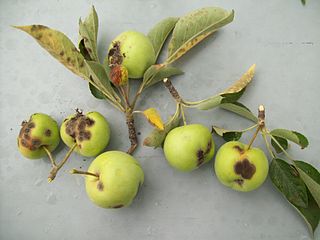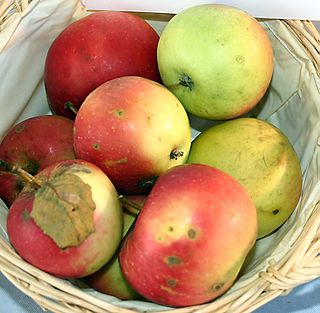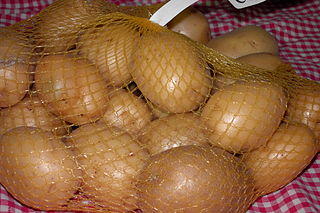Related Research Articles

'Pinova' is a German apple cultivar. It was created in 1965 at the Institut für Obstforschung of Dresden–Pillnitz in Saxony which at that time was in the German Democratic Republic. After Germany was re-united in 1990, the rights to the cultivar passed to the Free State of Saxony.

Apple scab is a common disease of plants in the rose family (Rosaceae) that is caused by the ascomycete fungus Venturia inaequalis. While this disease affects several plant genera, including Sorbus, Cotoneaster, and Pyrus, it is most commonly associated with the infection of Malus trees, including species of flowering crabapple, as well as cultivated apple. The first symptoms of this disease are found in the foliage, blossoms, and developing fruits of affected trees, which develop dark, irregularly-shaped lesions upon infection. Although apple scab rarely kills its host, infection typically leads to fruit deformation and premature leaf and fruit drop, which enhance the susceptibility of the host plant to abiotic stress and secondary infection. The reduction of fruit quality and yield may result in crop losses of up to 70%, posing a significant threat to the profitability of apple producers. To reduce scab-related yield losses, growers often combine preventive practices, including sanitation and resistance breeding, with reactive measures, such as targeted fungicide or biocontrol treatments, to prevent the incidence and spread of apple scab in their crops.
Red Gold potato is an early variety of North American potato. It has a red skin with yellow flesh inside. It is resistant to potato leafroll virus and potato virus Y and moderately resistant to common scab, but is susceptible to potato virus a and potato virus s.

The Jonathan apple is a medium-sized sweet apple, with a touch of acid and a tough but smooth skin. It is closely related to the Esopus Spitzenburg apple, good for eating fresh and for cooking.

Venturia inaequalis is an ascomycete fungus that causes the apple scab disease.

Malus floribunda, common name Japanese flowering crabapple, Japanese crab, purple chokeberry, or showy crabapple, originates from Japan and East Asia. It may be a wild species, or a hybrid of M. sieboldii × M. baccata.

Claygate Pearmain is an apple cultivar. It was found at Claygate, Surrey in England and brought to the attention of the Royal Horticultural Society by John Braddick in 1821. The apple was a popular eating apple in Victorian times and spread through England and to America.
The Brina apple is an apple cultivar that was first developed in the Italy in the 1979s by open pollination PRI 2059-101 apples.

The Agata is a Dutch potato variety. It is a very early maturing, yellow-skinned, yellow-fleshed variety with an attractive bright skin. Agata produces high yields of uniform shaped tubers and is known for its high pack-out. It was bred by Svalöf Weibull A.B., from the cross BM 52-72 X Sirco in Emmeloord in 1976.

Topaz is a cultivar of dessert apple that was developed in Czech Republic by the Institute of Experimental Botany for scab resistance. According to Orange Pippin it is "one of the best modern disease-resistant varieties, with fairly sharp flavour".
Applecrabs are various hybrids between crabapples and apples. They are bred for varying reasons, including disease resistance and use in cold climates because they are often hardier than apple trees and their fruit has the good eating qualities of apples.

Rajka is a hybrid cultivar of domesticated apple from the Czech Republic, specifically for eating. Rajka was crossed and developed by the Institute of Experimental Botany from the Champion and Katka apples for scab resistance, hence possible to grow organic.

Pristine apple is a hybrid cultivar of 'Co Op 10' x 'Camuzat' domesticated apples, which are descendants of the 'McIntosh' apple and the 'Starking Delicious'. This cultivar was developed and patented in the United States by the PRI disease resistant apple breeding program, in Indiana, United States in 1994, for its resistance to apple scab. It is susceptible to cedar-apple rust.
The PRI disease resistant apple breeding program is a joint project of the Purdue University, Rutgers University, and the University of Illinois, to breed apple cultivars to be resistant to apple scab. PRI stands for 'P'urdue, 'R'utgers and 'I'llinois.

'Ariane' is a modern cultivar of domesticated apple that was recently developed in France for scab resistance.
Enterprise is a modern bred, late-ripening and attractive, red cultivar of domesticated apple with excellent fruit quality combined with disease resistance to scab, cedar apple rust, fire blight and some resistance to powdery mildew. The fruit is large and attractive and retains excellent fresh quality for up to six months at 1°C. Its moderate acidity at time of harvest mellows in storage, and it is best after one month of storage.

The 'Prima' apple is one of the modern disease resistant cultivars of domesticated apple which was bred by the PRI disease resistant apple breeding program in 1958. The disease resistance against apple scab has since been broken.
Dufflin is an old variety of cider apple from the County of Cornwall, England. It was included in orchard trials by Long Ashton Research Station in 1957.
Pike is a variety of potato bred by the Cornell and Pennsylvania Experimental Stations in March 1996. This clone originated from a cross made in 1981, between 'Allegany' and 'Atlantic potato' varieties. It is resistant to infection by golden nematode, common scab, golden necrosis, and foliage infection by Phytophthora. Pike is intended to be used agriculturally, specifically for use in potato chips.
Aia Ilu is a cultivar of domesticated apple, from Estonia, first developed in 1946 by Aleksander Siimon.
References
- ↑ Bergamini, A.; Giongo, L. (2002), "Three New Scab Resistant Apples: Golden Lasa, Summerfree and Golden Orange", Acta Horticulturae, International Society for Horticultural Science (ISHS), Leuven, Belgium (595): 69–73, doi:10.17660/ActaHortic.2002.595.10
